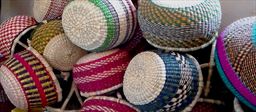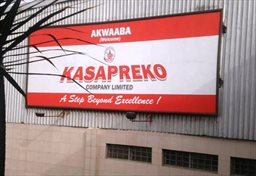Crafts and Curios
Crafts and Curios
Overview
Ghana produces a great number of goods that are easily available for you to purchase to take back home. Most crafts in Ghana are quite beautiful and serve a functional purpose.
An enormous amount of purchases can be made from the comfort of your car. Street vendors are everywhere, and anytime your car stops, you are instantly surrounded by a convenience store selling food, beverages, toilet paper, clothing, phone credits and just about anything else you can imagine.
Ghana is famous for her open-air markets. Kejetia market in Kumasi claims to be West Africa's largest outdoor market. Makola market in Accra and Takoradi's Market Circle are also famous open-air markets, while Techiman's food market is reportedly the largest food market in West Africa.
At the other end of the spectrum is the Accra Mall, an air-conditioned shopping mall that would be familiar to any Western shopper. In all large cities there are many upscale boutiques for crafts, clothing and art.
Finally, in today's Internet world, it should be mentioned that there are some local Ghanaian craftsmen selling their goods online at Novica.com, a site that gives craftspeople from around the world access to a Western market.
Paintings and Contemporary Art
For professional art and painting, there are a number of exclusive galleries in Accra.
- Wild Gecko in East Legon, near the Gulf House
www.wild-gecko.com - The Loom, in Adabraka, south of Nkrumah Circle on Kwame Nkrumah Avenue.
Contemporary paintings and upscale art.
021 224 746 - Nubuke Foundation
African Market in Osu selling upscale productsArts exibitions, film screenings and performance art are to be found at this wonderful gallery in East Legon. A café is on site as well.
Music and Musical Instruments
Many visitors enjoy returning home with the sounds of Ghana. See our section on Music, Dance & Ceremony for a description of the music in Ghana.
- Recorded music
Music apps such as Audiomack, Spotify, Aftown, Soundcloud, Boomplay and others are great places to find Ghanaian highlife, hiplife and reggae to listen to on your iPhones or Android phones. Bring a flash drive if you want your guide to load it with current tunes for you! - Drums
Drums are an important part of culture in Ghana. Many men will know how to drum in Ghana, and there are many craftsmen who can make drums. The National Culture Center in Accra has many drum makers. Your Easy Track Ghana guide can help locate a craftsperson who can create something special just for you. - Other musical instruments
Other musical instruments are available from craftspeople around the country, most notably xylophones, axatse (rattles), string instruments, calabash and gankogui (iron bell or gong).
Cloth and Clothing
For men or women, your top is referred to as a 'dress'.
- Kente cloth
This is the bright traditional hand-woven cloth that immediately comes to mind when you think of Ghana. Worn over the left shoulder, Kente was declared a national cloth upon independence in 1957. Today, in addition to cloth for wearing, Kente is used to create many decorative items, such a caps, belts, bags, wristbands, or window coverings. There are about 50 types of Kente patterns. Each symbol or design on the cloth has a meaning, allowing the cloth to have a special significance.
You can find weavers all around the country, but the major Kente centers are in the Ashanti Region and the Volta Region. Using hand looms, weavers create strips of cloth about 4 inches wide. These strips are sewn together to make larger cloths. A full-size male cloth for wearing, about 8 feet by 10 feet, can take up to 6 months to weave and can be purchased for around $300 in a Kente village or at Kumasi's Kejetia market, or for a higher price in Accra.
Visit the online shop of the Adanwomase Kente village. Order online and pick up when you visit the village on a tour with Easy Track Ghana. - Adinkra cloth
This is cloth that is hand-stamped with monochrome Adinkra symbols. There are over 60 different Adinkra symbols, each representing a different tradition or proverb.
Also worn over the shoulder, the traditional darker colored cloth, such as red, brown and black are worn at funerals. Less traditional lighter color cloth is worn for more joyful occasions. The durable ink used to stamp the cloth is obtained by boiling the bark of the badie tree with iron oxide.
Produced throughout Ghana on a small scale, it is the village of Ntonso, on the Kumasi-Mampong road that is recognized as the main production centre for Adinkra cloth. - Gonja cloth
This is a white and indigo-dyed cloth from the Northern Region of Ghana. It is a heavy and strong cloth. Like Kente, it is hand woven on looms in vertical strips that are sewn together to make garments. Frafra shirts (smocks for men, around $20) and Fugu outfits (two-piece outfits) are made from Gonja cloth. The recognized capital of Gonja cloth making is Daboya, one of the oldest settlements in Ghana, about an hour west of Tamale. Gowrie is a Gonja village near Tamale that is somewhat easier to reach. - Ghana Clothing
While there are fashion & accessories everywhere in Ghana, for the discerning visitor, there is a flourishing fashion industry with invigorating new designers producing unique creations. Here are just a couple:
Linchpin Colours
Linchpin makes very beautiful female and male African dresses. You can visit their shop in the Easy Track neighbourhood to have you dress made for you.
Across from Al Masjid mosque on the Christian Village - Dome Road.
020 066 1566
https://linchpin-colours.business.site/
Nallem
Afrocentric clothing for adults and children.
Accra Mall 021 823 047
Achimota Mall 050 330 0048
www.nallemclothing.com
- Batik & Mass-produced African Prints
Everywhere you will see brightly colored African cloth being worn and for sale. It is sold in fabric shops, alongside provisions and by street vendors. It is generally around $3/yard.
While the designs and printing are done in Ghana, the cloth itself is typically gray baft and semi-finished / bleached cloth imported from China. Because of the growing competition of cheap imports, 3 of the largest textile companies, Ghana Textile Print (GTP), Ghana Textile Manufacturing Company (GTMC) and Printex, have shut down their spinning and weaving departments.
Only Akosombo Textile Limited (ATL) is still making some of its own cloth. Look for the ATL logo on the cloth you are buying.
Buy some cloth and have a tailor sew you an outfit while in Ghana. Tailors are everywhere and will quickly and inexpensively prepare your 'dress'. For men or women, your top is referred to as a 'dress'. - Western clothing
Ghana is flooded with second-hand Western clothing. It is easy to find designer-label clothing in very good condition for a fraction of what you would pay at home. While not exactly an African souvenir, there are great deals to be had. Makola Market in Accra and Kejetia Market in Kumasi are great places for this type of shopping experience. - Hats, Sunglasses, Underwear & Socks
Again, not exactly souvenirs, but basic gear is very easy to find and cheap to buy. All the basics are sold by street vendors and a good proportion of shops sell such clothing.
Beads, Gold and Jewelry
Beads are worn by many people in Ghana. Every shape, size and color imaginable will be seen around wrists, necks, waists and ankles. The Ghanaian bead making process uses bauxite, iron, shell, clay, bone and recycled glass. Made by men, it takes several years of apprenticeship to be able to form some of the intricate patterns associated with African beads.
A set of bead factories and bead markets are in close proximity to each other, These include the following:
- TK Beads, near Accra, 10 minutes north of the Adenta junction.
024 472 7853 or 024 486 2809 - The Thursday bead market at Koforidua, capital of the Eastern Region, has one of the biggest selections of beads in Ghana.
- Cedi's Bead Factory
About 3km north of Somanya, heading towards Kpong. - Dan's Beaded Handicrafts
About 3km south of Kpong on the Accra road. - Abompe Traditional Bead Making Village
Various tours and workshops allow visitors to see every aspect of creating bauxite beads, from a tour of the bauxite mines to a full-day bead-making workshop. About 10 minutes north of the Bunso junction, just past Anyinam on the Accra-Kumasi road. - The Agomanya market on Wednesdays and Sundays is an exceptional display of beads. About 3km from Kpong on the Somanya-Kpong road.
Gold and other jewelry can also be found throughout Ghana. But exercise caution when approached by anyone offering to sell you gold or diamonds. Keep your purchases of these items to an accredited retailer.
The Anglogold Ashanti mining company operates the world's richest single gold mine by output at Obuasi in the Ashanti Region, 85 km south of Kumasi. After South Africa, Ghana is now the second largest gold producer in Africa. Tours of the mine can be arranged and gold fashions and accessories are plentiful here to purchase.
Carvings and Masks
From household good to decorative figurines, many things are created by craftsmen using Ghana's most abundant resource: wood. While the set of products cannot be fully detailed here, these are some of the major items of wood you may find in Ghana.
- Stools
It is the Ashanti belief that the stool is the receptacle of the soul. Chiefs are enstooled and when they die their stools are preserved with great ceremony in shrines. Stools are also everyday items, used instead of chairs. They range from simple and unadorned to beautiful sculptures. A male stool has straight legs, while a female stool has curved legs. - Akuaba fertility doll
Another carving that is intimately associated with Ghana is the Akuaba fertility doll. Pregnant women will carry these so their child will be born with the same beauty as expressed in the doll. A perfectly round head is a mark of beauty in Ghana culture. Women who wish to become pregnant will also carry these dolls. - Masks
While Ghana does not have a strong tradition of masks like other countries, there are a number of indigenous masks to be found. Masks from throughout Africa are available at shops in markets in Ghana. - Calabash
A calabash is a catch-all term referring to a carved gourd. It can be just a plain bowl that is used to drink from, or an enormous bowl for carrying water or use as a musical instrument. Others are intricately carved and decorated with lids, making them appropriate as decorative boxes. - Coffins
Ghana has a set of exquisite coffin makers in the Accra suburb of Teshie-Nunga who carve exotic coffins in any shape - animal, automobile, house, shoe, fish, bottle, etc. The craft shops are interesting to visit, and your own museum-quality coffin can be carved and shipped almost anywhere.
Read more or visit the website of the Kane Kwei Carpentry Workshop.
Leather
Ghana has a distinctive leather tradition, producing many items from this durable and versatile material in a range of colors, textures and finishes. Leather is crafted into all types of products, including belts, shoes and bags, as well as cushions, rugs, jewelry boxes and a myriad more objects. These products can be found throughout Ghana, but it is in the north where the main tanneries, and hence better prices, are located.
People of the north have a nomadic tradition, so an animal skin is viewed as a versatile and invaluable possession. The skin serves as the chief's throne, equivalent to the stool in the south. The number of skins a chief sits upon is not an indication of status, but instead it is the type of skin. The more fierce the animal, the more powerful the chief.
In Tamale, the Zongo Leather Factory is an excellent place to see the leather making process and to make outstanding purchases with little hassle.
Pottery
Traditional pottery in Ghana is simple and functional. It is one of the few crafts that is traditionally produced by women, but many men are contemporary potters using design departures from the women's traditional pots.
Glaze is not common on traditional pottery and the color of the pot depends largely on the type of clay used, although some pots are black from the smoke created during firing. Pots are still used to prepare, cook, and store food.
Perhaps the most functional is the grinding bowl which is shallow with ridges on the inside. Food is ground with a small wooden pestle.
Pots are low fired, and therefore fragile. They are inexpensive and for sale in every market and often on the roadside.
In the Volta Region there are superb potters in the Kpando area, including the Fesi Shed of Kpando Potters.
093 650 413 or 020 817 5596
Kpando Pottery website
The Upper East Region boasts two significant pottery villages:
The Village of Pottery Art and Culture (VOPAC) is 8km west of Bolgatanga on the main road to Navrango.
024 467 1562
The Sirigu Women's Organization for Pottery and Art (SWOPA) at Sirigu, also off the main road to Navrongo.
SWOPA website
Weaving
Whether it be tiny baskets, entire rooms of furniture, or anything in between, the weaving industry produces some outstanding crafts.
Traditional baskets are woven by men of the FraFra tribe in the northern city of Bolgatanga. Known as Bolga baskets, these baskets are exceptionally beautiful. Modern versions of baskets reflect the tastes of tourists and the creativity of the basket makers who are no longer bound by tradition. Some women have been organized into basket making cooperatives so that they can supplement their seasonal farming.
Food and Beverage
There are a number of food and beverages that you may wish to bring home from Ghana. While palm wine does not keep more than a couple days, akpeteshie does travel well. Akpeteshie is distilled palm wine and has a good shelf life of about 3 months after opening.
For alcoholic beverages produced in a controlled setting, the Kasapreko beverage company produces a number of unique and exotic bitters which are easily transportable.
Chocolate may be the best known food from Ghana. Although most is shipped from Ghana in its unprocessed form as cocoa, there are the locally produced Kingsbite chocolate, ’57 chocolate and Omama Royal chocolate. Ghana's first cocoa farm, as well as a cocoa research institute, may be visited in Mampong in the Eastern Region.
Personal Care Products
Shea butter is widely used in cosmetics as a moisturizer and an emollient. It is a slightly yellowish or ivory-colored natural fat obtained by crushing and boiling the fruit of the Shea tree. Shea butter is the best moisturizer for dried skin and lips and can be most easily and cheaply be purchased at in the three northern regions.
Shea trees occurs over almost the entire area of Northern Ghana, with Eastern Gonja having the densest stands. Shea butter is also edible, used as a cooking oil in West Africa, as well as sometimes being used in the chocolate industry as a substitute for cocoa butter.
A natural Black Soap is also produced in Ghana using Shea butter and honey. Hand-made in Ghana, and coming in a liquid and a solid form, this soap claims to improve skin tone, moisturize, and heal scars or stretch marks.
The Ele Agbe company produces many Shea products.
024 415 2263 or 020 816 5933
www.eleagbe.com
Some Traditional Crafts from Ghana
(Note: There are no paid recommendations on this page. We link businesses on our site because of their unique offerings - not because they provide any incentives to Easy Track Ghana or our staff.)



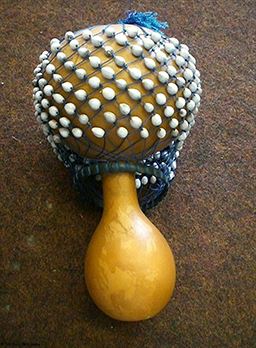
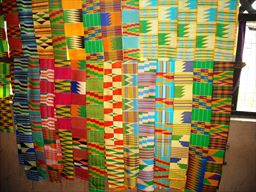
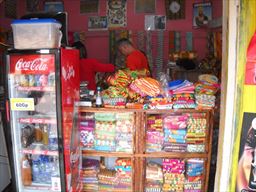
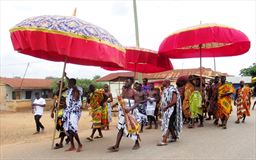
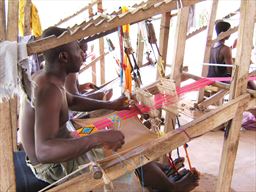
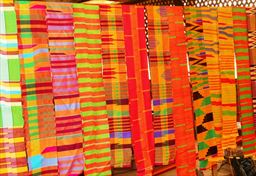
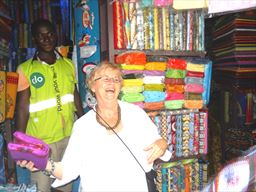
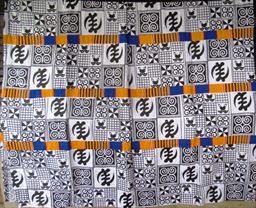

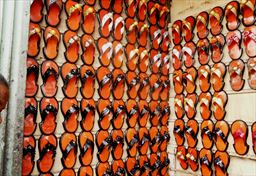
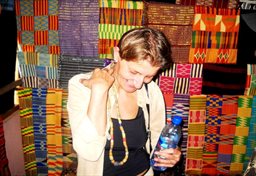

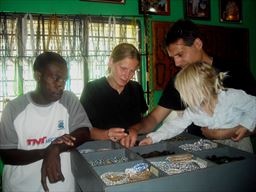
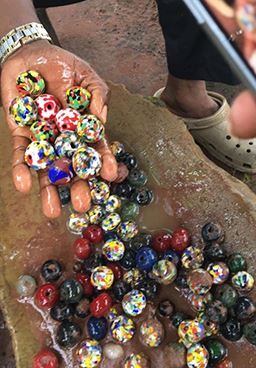
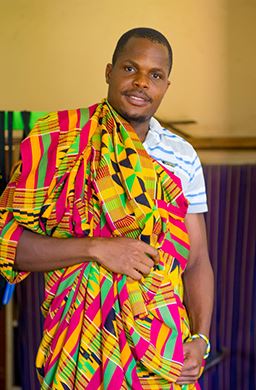
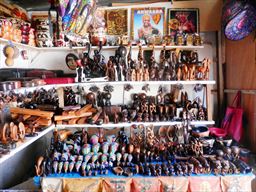
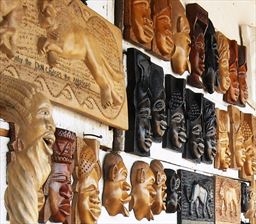
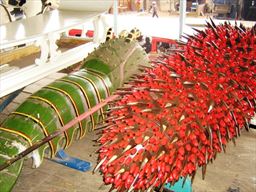

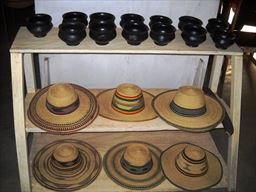
.JPG)

